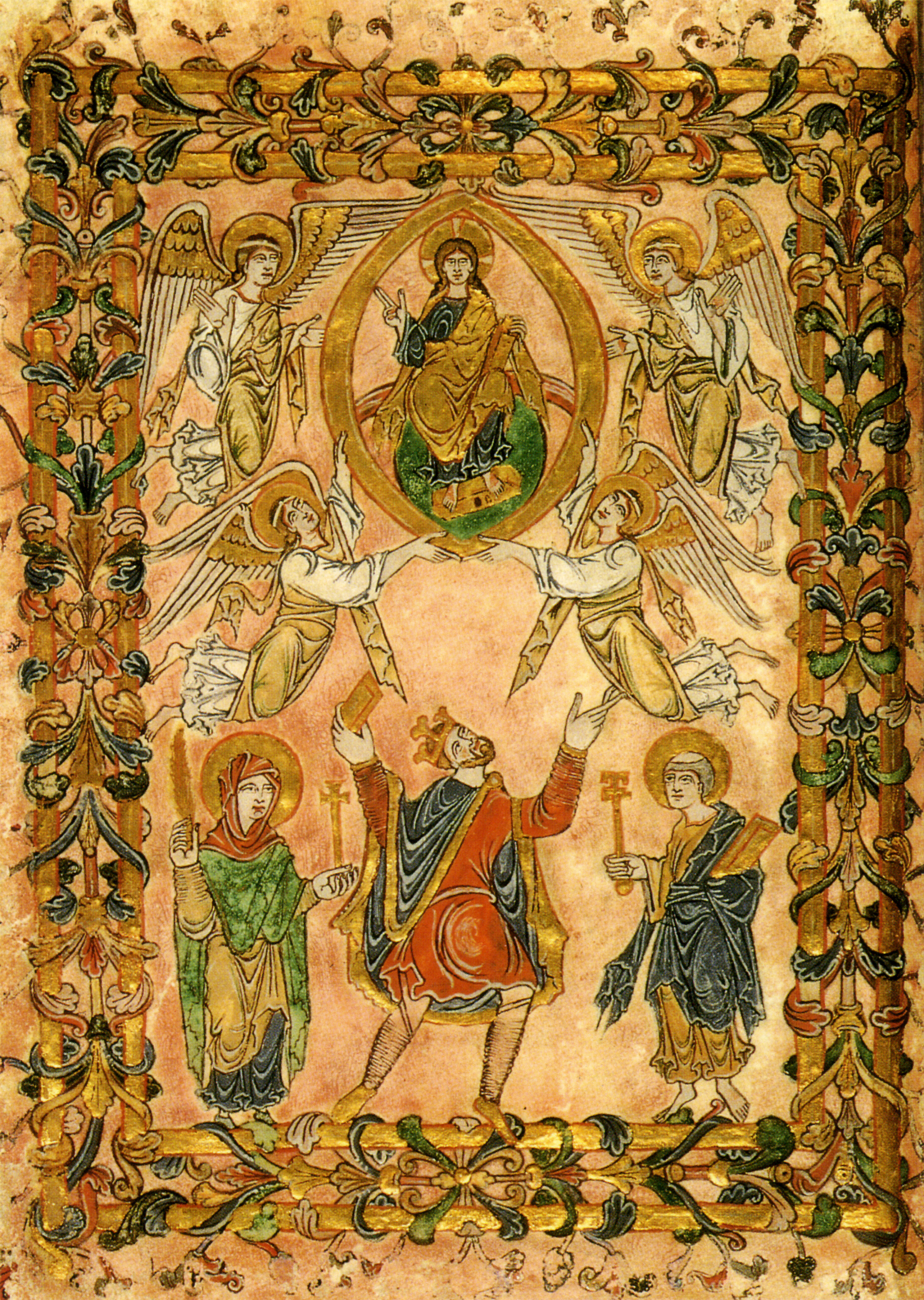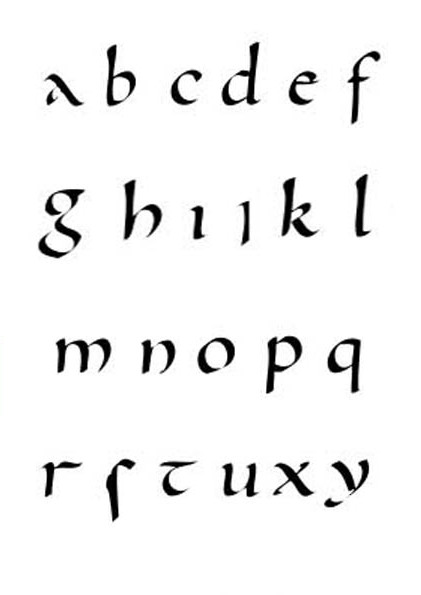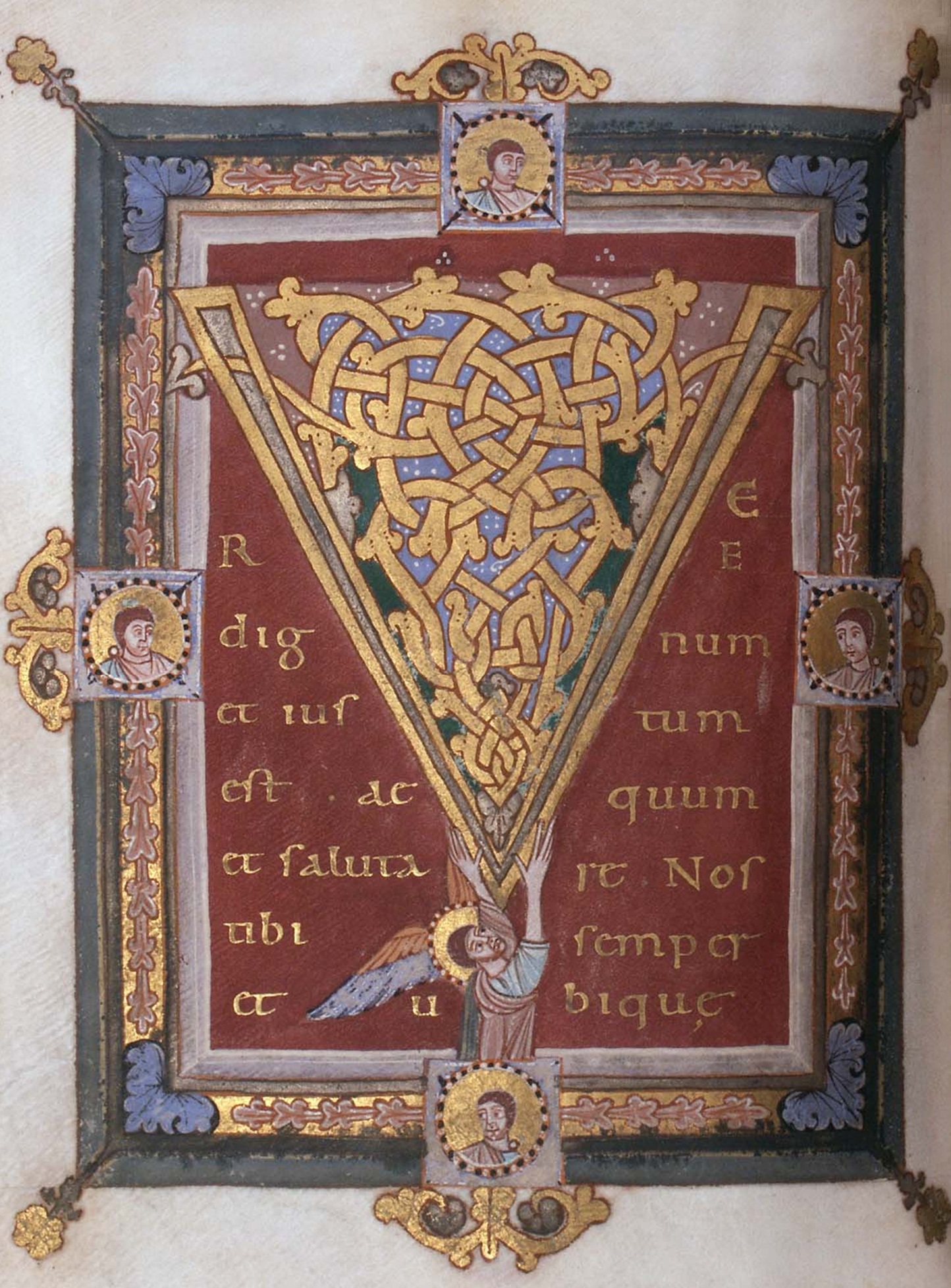|
New Minster Charter
The New Minster Charter is an Anglo-Saxon illuminated manuscript that was likely composed by Bishop Æthelwold and presented to the New Minster in Winchester by King Edgar in the year 966 AD to commemorate the Benedictine Reform. It is now part of the British Library's collection. Purpose and Content In approximately 963 AD, Bishop Æthelwold of Winchester required the monks of New Minster, under threat of eviction, to adopt Benedictine rule. This decision was made with the approval of King Edgar, who reigned in England from 959 until his death in 975. The charter was officially created as a codex to compile and present the royal grants which established the new laws of the New Minster, later to become Hyde Abbey. It is one of 34 surviving documents from the pre-Conquest archive of the New Minster, and stands out as an authentic document among numerous forgeries of its time.Miller, 2001 The text consists of 22 short chapters which outline the creation and fall of both angels ... [...More Info...] [...Related Items...] OR: [Wikipedia] [Google] [Baidu] |
Edgar From Winchester Charter
Edgar is a commonly used English given name, from an Anglo-Saxon name ''Eadgar'' (composed of '' ead'' "rich, prosperous" and ''gar'' "spear"). Like most Anglo-Saxon names, it fell out of use by the later medieval period; it was, however, revived in the 18th century, and was popularised by its use for a character in Sir Walter Scott's ''The Bride of Lammermoor'' (1819). People with the given name * Edgar the Peaceful (942–975), king of England * Edgar the Ætheling (c. 1051 – c. 1126), last member of the Anglo-Saxon royal house of England * Edgar of Scotland (1074–1107), king of Scotland * Edgar Angara, Filipino lawyer * Edgar Barrier, American actor * Edgar Baumann, Paraguayan javelin thrower * Edgar Bergen, American actor, radio performer, ventriloquist * Edgar Berlanga, American boxer * Edgar H. Brown, American mathematician * Edgar Buchanan, American actor * Edgar Rice Burroughs, American author, creator of ''Tarzan'' * Edgar Cantero, Spanish author in Catala ... [...More Info...] [...Related Items...] OR: [Wikipedia] [Google] [Baidu] |
Carolingian Minuscule
Carolingian minuscule or Caroline minuscule is a script which developed as a calligraphic standard in the medieval European period so that the Latin alphabet of Jerome's Vulgate Bible could be easily recognized by the literate class from one region to another. It is thought to have originated before AD 778 at the scriptorium of the Benedictine monks of Corbie Abbey, about north of Paris, and then developed by Alcuin of York for wide use in the Carolingian Renaissance. Alcuin himself still wrote in a script which was a precursor the Carolingian minuscule, which slowly developed over three centuries. He was most likely responsible for copying and preserving the manuscripts and upkeep of the script. It was used in the Holy Roman Empire between approximately 800 and 1200. Codices, pagan and Christian texts, and educational material were written in Carolingian minuscule. After blackletter developed out of it, the Carolingian minuscule became obsolete, until the 14th century Ital ... [...More Info...] [...Related Items...] OR: [Wikipedia] [Google] [Baidu] |
10th-century Illuminated Manuscripts
1 (one, unit, unity) is a number representing a single or the only entity. 1 is also a numerical digit and represents a single unit (measurement), unit of counting or measurement. For example, a line segment of ''unit length'' is a line segment of length 1. In conventions of sign where zero is considered neither positive nor negative, 1 is the first and smallest Positive number, positive integer. It is also sometimes considered the first of the sequence (mathematics), infinite sequence of natural numbers, followed by 2, although by other definitions 1 is the second natural number, following 0. The fundamental mathematical property of 1 is to be a multiplicative identity, meaning that any number multiplied by 1 equals the same number. Most if not all properties of 1 can be deduced from this. In advanced mathematics, a multiplicative identity is often denoted 1, even if it is not a number. 1 is by convention not considered a prime number; this was not universally ac ... [...More Info...] [...Related Items...] OR: [Wikipedia] [Google] [Baidu] |
Benedictional Of St
In the Western Church of the Early and High Middle Ages, a sacramentary was a book used for liturgical services and the mass by a bishop or priest. Sacramentaries include only the words spoken or sung by him, unlike the missals of later centuries that include all the texts of the mass whether read by the bishop, priest, or others. Also, sacramentaries, unlike missals, include texts for services other than the mass such as ordinations, the consecration of a church or altar, exorcisms, and blessings, all of which were later included in Pontificals and Rituals instead. In the late 20th century, the word ''sacramentary'' was used in the United States and some other English-speaking countries for the English translation of the Roman Missal, particularly those that, like earlier sacramentaries, omitted parts of the Mass not said by the priest. Decline of the sacramentary Other books used in the celebration of Mass included the Graduale (texts mainly from the Psalms, wit ... [...More Info...] [...Related Items...] OR: [Wikipedia] [Google] [Baidu] |
Acanthus (ornament)
The acanthus ( grc, ἄκανθος) is one of the most common plant forms to make foliage ornament and decoration, and even as the leaf distinguishing the heraldic coronet of a manorial lord from other coronets of royalty or nobility, which use strawberry leaves. Architecture In architecture, an ornament may be carved into stone or wood to resemble leaves from the Mediterranean species of the '' Acanthus'' genus of plants, which have deeply cut leaves with some similarity to those of the thistle and poppy. Both ''Acanthus mollis'' and the still more deeply cut ''Acanthus spinosus'' have been claimed as the main model, and particular examples of the motif may be closer in form to one or the other species; the leaves of both are, in any case, rather variable in form. The motif is found in decoration in nearly every medium. The relationship between acanthus ornament and the acanthus plant has been the subject of a long-standing controversy. Alois Riegl argued in his ''Stilfragen ... [...More Info...] [...Related Items...] OR: [Wikipedia] [Google] [Baidu] |
Charles The Bald
Charles the Bald (french: Charles le Chauve; 13 June 823 – 6 October 877), also known as Charles II, was a 9th-century king of West Francia (843–877), king of Italy (875–877) and emperor of the Carolingian Empire (875–877). After a series of civil wars during the reign of his father, Louis the Pious, Charles succeeded, by the Treaty of Verdun (843), in acquiring the western third of the empire. He was a grandson of Charlemagne and the youngest son of Louis the Pious by his second wife, Judith. Struggle against his brothers He was born on 13 June 823 in Frankfurt, when his elder brothers were already adults and had been assigned their own ''regna'', or subkingdoms, by their father. The attempts made by Louis the Pious to assign Charles a subkingdom, first Alemannia and then the country between the Meuse and the Pyrenees (in 832, after the rising of Pepin I of Aquitaine) were unsuccessful. The numerous reconciliations with the rebellious Lothair and Pepin, as well as ... [...More Info...] [...Related Items...] OR: [Wikipedia] [Google] [Baidu] |
Carolingian Art
Carolingian art comes from the Frankish Empire in the period of roughly 120 years from about 780 to 900—during the reign of Charlemagne and his immediate heirs—popularly known as the Carolingian Renaissance. The art was produced by and for the court circle and a group of important monasteries under Imperial patronage; survivals from outside this charmed circle show a considerable drop in quality of workmanship and sophistication of design. The art was produced in several centres in what are now France, Germany, Austria, northern Italy and the Low Countries, and received considerable influence, via continental mission centres, from the Insular art of the British Isles, as well as a number of Byzantine artists who appear to have been resident in Carolingian centres. There was for the first time a thoroughgoing attempt in Northern Europe to revive and emulate classical Mediterranean art forms and styles, that resulted in a blending of classical and Northern elements in a sumptuo ... [...More Info...] [...Related Items...] OR: [Wikipedia] [Google] [Baidu] |
Book Frontispiece
A frontispiece in books is a decorative or informative illustration facing a book's title page—on the left-hand, or verso, page opposite the right-hand, or recto, page. In some ancient editions or in modern luxury editions the frontispiece features thematic or allegory, allegorical elements, in others is the author's portrait that appears as the frontispiece. In medieval illuminated manuscripts, a presentation miniature showing the book or text being presented (by whom and to whom varies) was often used as a frontispiece. Origin The word comes from the French language, French ''frontispice'', which derives from the late Latin ''frontispicium'', composed of the Latin ''frons'' ('forehead') and ''specere'' ('to look at'). It was synonymous with 'metoposcopy'. In English, it was originally used as an frontispiece (architecture), architectural term, referring to the decorative facade of a building. In the 17th century, in other languages as in Italian language, Italian, the term cam ... [...More Info...] [...Related Items...] OR: [Wikipedia] [Google] [Baidu] |
Chi Rho
The Chi Rho (☧, English pronunciation ; also known as ''chrismon'') is one of the earliest forms of Christogram, formed by superimposing the first two (capital) letters— chi and rho (ΧΡ)—of the Greek word ( Christos) in such a way that the vertical stroke of the rho intersects the center of the chi. The Chi-Rho symbol was used by the Roman Emperor Constantine I (r. 306–337 AD) as part of a military standard (vexillum). Constantine's standard was known as the Labarum. Early symbols similar to the Chi Rho were the Staurogram () and the IX monogram (). In pre-Christian times, the Chi-Rho symbol was also used to mark a particularly valuable or relevant passage in the margin of a page, abbreviating ''chrēston'' (good). Some coins of Ptolemy III Euergetes (r. 246–222 BC) were marked with a Chi-Rho. Although formed of Greek characters, the device (or its separate parts) is frequently found serving as an abbreviation in Latin text, with endings added appropriate t ... [...More Info...] [...Related Items...] OR: [Wikipedia] [Google] [Baidu] |
Insular Art
Insular art, also known as Hiberno-Saxon art, was produced in the post-Roman era of Great Britain and Ireland. The term derives from ''insula'', the Latin term for "island"; in this period Britain and Ireland shared a largely common style different from that of the rest of Europe. Art historians usually group Insular art as part of the Migration Period art movement as well as Early Medieval Western art, and it is the combination of these two traditions that gives the style its special character. Most Insular art originates from the Irish monastic movement of Celtic Christianity, or metalwork for the secular elite, and the period begins around 600 with the combining of Celtic and Anglo-Saxon styles. One major distinctive feature is interlace decoration, in particular the interlace decoration as found at Sutton Hoo, in East Anglia. This is now applied to decorating new types of objects mostly copied from the Mediterranean world, above all the codex or book. The finest ... [...More Info...] [...Related Items...] OR: [Wikipedia] [Google] [Baidu] |
Anglo-Saxons
The Anglo-Saxons were a Cultural identity, cultural group who inhabited England in the Early Middle Ages. They traced their origins to settlers who came to Britain from mainland Europe in the 5th century. However, the ethnogenesis of the Anglo-Saxons happened within Britain, and the identity was not merely imported. Anglo-Saxon identity arose from interaction between incoming groups from several Germanic peoples, Germanic tribes, both amongst themselves, and with Celtic Britons, indigenous Britons. Many of the natives, over time, adopted Anglo-Saxon culture and language and were assimilated. The Anglo-Saxons established the concept, and the Kingdom of England, Kingdom, of England, and though the modern English language owes somewhat less than 26% of its words to their language, this includes the vast majority of words used in everyday speech. Historically, the Anglo-Saxon period denotes the period in Britain between about 450 and 1066, after Anglo-Saxon settlement of Britain, th ... [...More Info...] [...Related Items...] OR: [Wikipedia] [Google] [Baidu] |
Hyde Abbey
Hyde Abbey was a medieval Benedictine monastery just outside the walls of Winchester, Hampshire, England. It was dissolved and demolished in 1538 following various acts passed under King Henry VIII to dissolve monasteries and abbeys (see Dissolution of the Monasteries). The Abbey was once known to have housed the remains of King Alfred the Great, his son, King Edward the Elder, and his wife, Ealswitha. Following its dissolution these remains were lost, however excavations of the Abbey and the surrounding area continue. History When Alfred the Great re-founded the royal city of Winchester in about 880, the Saxon cathedral and the royal palace stood at the heart of the city. As the city grew, land was purchased in the city in the last year of Alfred's reign, and work was begun on the New Minster, beside the Old Minster, under the direction of Edward the Elder. When it was sufficiently complete, about 903, it was consecrated and fully endowed; the abbot Grimbald (died 8 July 901 ... [...More Info...] [...Related Items...] OR: [Wikipedia] [Google] [Baidu] |










